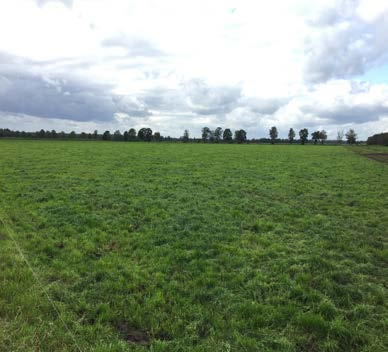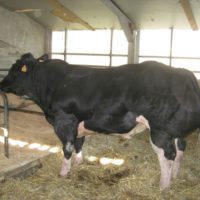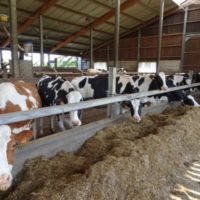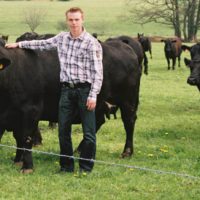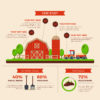Description
Background
Georg and Jan-Niklas Alter´s farm is a dairy farm located in Elsfleth in Northern Germany. It is a family-owned farm with 140 dairy cows of high genetic merit. The farm is located in a permanent grassland region, that is characterized by the difficult soil type “upland moor”. Upland moor is a soil type with high carbon content, a very low yield potential and a high moisture content. During the summer the soil can dry out very fast. With a consequent grassland management, it has been possible to achieve a good yield potential of the sward after taking over the farm 45 years ago. The land was a natural reserve and has been extensively used before. Nowadays, the farm manages about 137 ha of permanent grassland as grazing and silage ground. Besides, the consequent grassland management Georg Alter focused on breeding to find the suitable cow for the system and the difficult land.
In the beginning Georg Alter was looking for a good technique to overseed the paddocks. The local contractor used a combination of a harrow and a seeder, but the germination rate of the grass was not satisfactorily for the farmer. Another contractor bought a new slots-seeder technique, which worked and achieved the desired result. Georg Alter bought finally the technique from the contractor, because of a low demand.
Further, the Chamber of Agriculture in Lower Saxony conducted several field trials on the farm to test the yield potential of different grass types and mixtures on upland moor. The experiments have shown that without sward maintenance the yield potential and the sward condition are decreasing dramatically after three years. The results proved that grassland on upland moor needs good management and regularly overseeding with new grass genetic.
Detailed description
Georg and Jan-Niklas´ grassland management pays off in high grass and milk yield, good health and a high feed efficiency. An intensive pasture/cutting rotation is practiced on the farm. About 137 ha of agricultural land were cut three to four times a year and between the cuts about 130 ha were grazed. Some paddocks were only grazed and the rotation starts in the end of April. The other paddocks were cut in May and grazed hereafter. Rotational grazing suits to the cutting/grazing rotation and the paddocks are grazed out well and the average yield of the paddocks is 10-12 t TM/ha, which is comparable high for the region. The paddock size is in average 3,5 ha and each paddock is grazed for approx. two to three days.
Due to the intensive pasture/cutting system, the paddocks are fertilised with slurry and with calcium ammonium nitrate (CAS). The first slurry application of 10 to 12 m³ will take place in March or as soon as the conditions allow it. Heavy rolling of the paddocks is necessary, because the upland moor can raise and shrunk due to temperature differences. Further, a harrow opens the sward and removes undesired grass types. A combination of a harrow and a seeder was displaced by a slot-seeder technique, because the seeds remain in the grass and do not have direct soil contact. The slot-seeder is used after the first cut under dry conditions, it places the seeds in 2 cm depth. The working width is only 2,5 m, which causes in high labor input for overseeding (1 ha/hour). Within three to four years every paddock is overseeded with new grass genetic. Alter farm always choose new grass varieties to improve the sward quality.
Results
The consequent grassland management on upland moor increased the feed efficiency on the farm. Grass is the basic feed on the farm and a great focus on sward quality and good silage results in a high production of 5000 to 5500 kg/milk/year/cow only from grass. During the summer the cows only get fresh grass on pasture and have access to hay. In winter and when it is not possible to graze, the cows get good quality grass silage. Concentrates are fed in the milking parlour and the amount depends on the cow´s milk yield. The cows have an average a milk production of 10,000 to 11,000 kg milk per year.
The milk production per kg basic feed increased over the last year. In addition to an excellent grassland management, the cows genetic improved as well. The farmers select healthy dairy cows with a high basic feed intake capacity, good grazing ability and a good feed efficiency. Many farmers and discussion groups visit the Alter farm to learn from their experience and their grassland management on difficult land. The land conditions are very difficult regarding low pH, low soil fertility and a low yield potential. Moreover, in spring and in autumn the land is too wet to drive or to use, which makes it impossible to expand the grazing period. Because of this the intensive focus on the sward is necessary and probably the key for a good production.
Adoption criteria
To adopt the system of the Alter farm you need to stay patient to see results, says Georg Alter. At the first view it seems like that the management is too costly and the labor input is too high. But the effort of constantly reseeding and overseeding is indispensable to achieve good yields on upland moor. Also, the investment into new machineries can pays off after some years. An own seeder can be useful in case of flexibility. The farmers are convinced about that the process of changing an established working step begins with mind-setting. An open-minded and sometimes a critical view on these established working steps can bring the farmer to new solutions.
Further, the farmers should spend money by choosing the right grass variety. Grass is the basis of a well-performing pasture and cutting system and new varieties improve the yield potential in general.
Future prospects
In future sharper fertilizer regulations will be the greatest challenge for the permanent grassland region. Especially on soils with high organic matter content the amount of nitrogen is limited. In order to this it will be challenging to realise the full yield potential of the grassland. A low fertilizer level will decrease the percentage of the desired grass types as English Ryegrass. Due to the soil conditions it is already difficult to maintain these grass types, but it will be even harder under more extensive conditions.
The farm invests in a trailing-shoe for the slurry trailer in the last years and increased the fertilizer efficiency. The farmers know that they need to put a stronger focus on fertilizer efficiency and other climate relevant topics.


